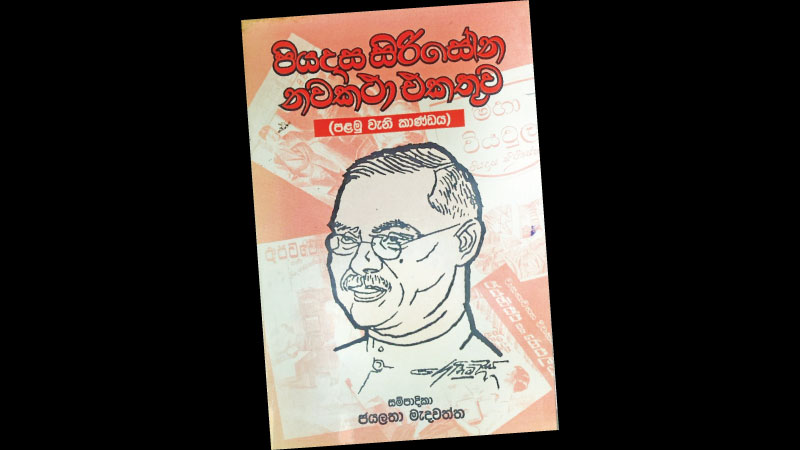Though the scholarly name, Piyadasa Sirisena, was a household name in the past, he and his volumes of narrative have not been assessed in terms of the modern awareness on the part of the local literary scholars. Piyadasa Sirisena (1875 – 1946) is known to have rendered a yeoman service in the capacity of a social reformer who was instrumental in moulding f a national reawakening, as a Sinhala journalist who happened to be the pioneer editor of Sinhala Jatiya first as a monthly journal and then as a weekly newspaper.
He selected the art of expression via both poetry and narrative forms that addressed the varying issues of nationalism and moral reawakening during and after the postcolonial rule. As August 31 happens to be his birthday, some of the literary comments on my part could be an ideal tribute to this communicator par excellence.
Resourceful introduction
We ought to be initially thankful for the compilation of his complete works, the novels he has written, by the Senior Lecturer of Sinhala and Mass Communication, Jayalatha Medawatta of the University of Sri Jayawardanapura.
The five volumes contain 19 of his Sinhala novels, of all types, with a profile and an introduction resourcefully presented. The period of his writings covers between 1904 and 1944. On reading that one of the pioneers remarkable creative work could be cited as the novel titled Apita Vechcha Dey chronologically ascertained as his second work.
The title, in English, could be rendered in English as ‘What befell us’. Taking an overview of the influence of the colonial rule, Sirisena peeps into the inner lives of those who benefitted from it but became the victims of the same as rootless individuals fallen prey to circumstances beyond one’s cognition.
He selects the family life of a Mudliyar (or Mudali), a title-bearer well known during the colonial times. The Mudliyar and his wife happen to be rich and have the only son named as Wilfred Vijayasinha. Wilfred, though given a good education, failed to live up to the parents’ expectations. This was solely due to the grandiose living conditions enjoyed in the utmost possible manner. With the money as earned by the father, the son had the chance to squander every penny to his heart’s desire before and after the demise of the former. The mother is made to suffer and she had failed to bring up the only son in the way she wished. He becomes a liquor addict and a club-goer who gathers like-minded friends from the similar family backgrounds.
Cultural susceptibilities
Sirisena, as a novelist, depicts Wilfred’s character as a rootless individual who fails to grasp the sensitive cultural susceptibilities of his own environment. Thus, it is shown how some women too reject him in matrimonial arrangements through the matchmakers. As an excessive drinker, he becomes physically disengaged. Gradually, he loses all his inherited money.
In his sickly mood, both body and mind, he cries out the words, apita vechcha dey (what befell us!) The onlookers see him as a mentally deranged or insane young man. But it so happens that a vein of sympathy and the prevailing social conditions create a wave of sympathy which moves him off to indigenous medical treatment. The protagonist is given clinical treatment having failed in the alien treatments. Gradually, Wilfred regains the physical and mental stability that leads him to certain areas in spiritualism.
Having become a changed person, he comes to grips with people who are balanced and clear-minded. Those who rejected him in the past rediscover him. One may call it a modern fairytale.
It could well be a present-day fairytale as everything turns out to be fine in the end. But if it could happen exactly that way is the inevitable question the writer himself poses. Piyadasa Sirisena is definitely a skilful creator of social events that open the doors to perceptive valve even for the contemporary read er. As a writer, he seems to experiment on the hazards of the so-called elitism, Occidentalism, new developmental trends and the rest as taught to us by the colonial rulers.
Sky heights
Now, please do not blame me for saying this. My attempt is not to elevate the Sirisena’s creative skills to sky heights. Instead, I need to perceive in the proper perspective what he tried to say to us. For a general reader, Sirisena via his characters and events presents several significant factors such as the value of being in a more humanistic frame of existence. Then he poses the question: how far can one go with the monetary riches and possesses? How much social power does one need?
All these questions are addressed, interspersed with a religious conscience. They are recreated via a poetic and a folkloristic attitude that enriches and broadens the vision of a reader. It should be remembered that some of our elders have grown up with this vision of Sirisena. As such, I feel that a discourse on Sirisena and his works is a compelling need at the moment.



Add new comment